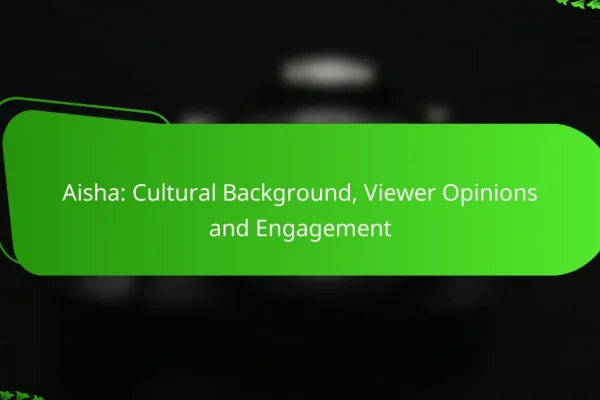How is Aisha received by audiences in the UK?
Aisha has garnered a varied reception from audiences in the UK, with many praising its themes and performances while others express mixed feelings about its execution. Overall, it has sparked significant discussion and engagement among viewers.
Positive critical acclaim
Many critics in the UK have lauded Aisha for its compelling storytelling and strong character development. The performances, particularly by the lead actor, have been highlighted as standout elements that resonate with audiences.
Review aggregators show that a substantial portion of critics rated the film positively, often citing its emotional depth and cultural relevance. This acclaim has contributed to a growing interest in similar narratives within the UK film landscape.
Mixed audience reactions
While Aisha has received praise, audience reactions have been more divided. Some viewers appreciate the film’s ambition and message, while others feel it falls short in pacing or plot coherence.
Social media discussions reveal that audiences are split on key aspects, such as character motivations and the film’s resolution. This mixed reception indicates that while Aisha has struck a chord with many, it has also left some viewers wanting more clarity and engagement in its storytelling.
What are the key themes resonating with viewers?
Viewers of “Aisha” are particularly drawn to themes of empowerment and identity, as well as cultural representation. These elements resonate deeply, reflecting personal and societal struggles that many can relate to.
Empowerment and identity
The theme of empowerment in “Aisha” highlights the journey of self-discovery and personal growth. Characters often face challenges that force them to confront their identities, leading to moments of strength and resilience.
For instance, the protagonist’s evolution from a passive role to an assertive figure inspires viewers to embrace their own identities. This narrative encourages audiences to reflect on their personal journeys and the importance of self-acceptance.
Cultural representation
“Aisha” effectively showcases diverse cultural backgrounds, allowing viewers to see their own experiences reflected on screen. This representation fosters a sense of belonging and validates the stories of underrepresented communities.
By incorporating authentic cultural elements, the film not only entertains but also educates audiences about different traditions and values. This approach invites discussions about inclusivity and the importance of diverse narratives in media.
How does Aisha compare to similar films?
Aisha stands out among similar films due to its unique storytelling and character development. While it shares themes with other notable films, its approach to cultural identity and personal growth offers a distinct viewing experience.
Comparison with ‘The Last Black Man in San Francisco’
Aisha and ‘The Last Black Man in San Francisco’ both explore themes of identity and belonging, but they do so through different lenses. ‘The Last Black Man in San Francisco’ focuses on gentrification and the loss of cultural heritage in a specific urban setting, while Aisha delves into personal and familial relationships within a broader cultural context.
Both films utilize rich visual storytelling and strong character arcs, but Aisha tends to emphasize emotional resilience and personal transformation more prominently. This difference in focus can lead to varied audience interpretations and emotional responses.
Comparison with ‘Moonlight’
Aisha shares thematic similarities with ‘Moonlight’, particularly in its exploration of identity and the complexities of personal relationships. Both films present nuanced portrayals of their protagonists’ struggles with self-acceptance and societal expectations.
However, Aisha often incorporates a more vibrant cultural backdrop, which contrasts with the more subdued tone of ‘Moonlight’. This difference in atmosphere can affect how audiences connect with the characters and their journeys, making Aisha a more colorful yet equally poignant narrative.
What demographic factors influence audience reception?
Demographic factors such as age and gender significantly shape audience reception of media like “Aisha.” Understanding these influences helps creators tailor content to better engage specific viewer segments.
Age group preferences
Different age groups exhibit distinct preferences when it comes to themes, storytelling styles, and character development in media. For instance, younger audiences may favor fast-paced narratives and relatable characters, while older viewers might appreciate deeper, more complex storylines.
Content creators should consider these preferences when developing their work. Engaging younger viewers might involve incorporating contemporary issues and humor, whereas appealing to older demographics may require a focus on nostalgia and emotional depth.
Gender perspectives
Gender can also play a crucial role in how audiences perceive and connect with media. Research indicates that women often seek relatable characters and emotional resonance, while men may prioritize action and plot-driven narratives.
To effectively reach a diverse audience, creators should strive for balanced representation and multifaceted characters. This approach not only broadens appeal but also fosters a more inclusive viewing experience, catering to varying interests and perspectives.
What are the critical reviews of Aisha?
The critical reviews of Aisha highlight a mix of perspectives, with some praising its storytelling and performances while others critique its pacing and character development. Overall, the film has garnered attention for its unique approach to themes of identity and culture.
Top critic reviews
Top critics have generally acknowledged Aisha’s ambition in addressing complex social issues. Many reviews commend the lead performances, particularly noting the emotional depth brought to the characters. However, some critics point out that the film’s narrative can feel uneven, leading to moments where the pacing drags.
For instance, a prominent film critic remarked on the film’s ability to engage with contemporary themes, yet suggested that tighter editing could have enhanced its impact. The cinematography received praise, with several reviews highlighting its vibrant visuals that complement the story.
User-generated reviews
User-generated reviews of Aisha reflect a diverse range of opinions, with many viewers enjoying the film’s relatable characters and engaging plot. Audience members often express appreciation for the film’s humor and emotional resonance, making it a favorite for those seeking a heartfelt narrative.
However, some users have echoed the concerns of critics regarding pacing, noting that certain scenes felt prolonged. Overall, the film has sparked discussions among viewers, with many recommending it for its thought-provoking content and strong performances.
What marketing strategies were used for Aisha?
The marketing strategies for Aisha included a mix of social media campaigns and influencer partnerships designed to engage a wide audience and create buzz around the film. These approaches focused on leveraging digital platforms to maximize reach and impact.
Social media campaigns
Social media campaigns for Aisha utilized platforms like Instagram, Facebook, and Twitter to create engaging content that resonated with potential viewers. The campaigns featured trailers, behind-the-scenes footage, and interactive posts to build anticipation and encourage audience participation.
Key tactics included targeted ads and hashtag challenges that encouraged users to share their own content related to the film. This not only increased visibility but also fostered a community around the movie, enhancing viewer connection and excitement.
Influencer partnerships
Influencer partnerships played a crucial role in Aisha’s marketing strategy by tapping into established audiences and enhancing credibility. Collaborating with popular figures in the film and entertainment industry allowed the campaign to reach diverse demographics effectively.
These influencers shared their personal experiences with the film, often through reviews or exclusive previews, which helped to generate authentic buzz. Selecting influencers whose followers align with the target audience was essential to ensure the messaging resonated well and drove engagement.
What future trends can be anticipated in audience reception?
Future trends in audience reception are likely to emphasize diversity and be significantly influenced by streaming platforms. As audiences become more global and interconnected, their preferences will shape how content is created and distributed.
Increased focus on diversity
As audiences demand more representation, creators are increasingly focusing on diversity in storytelling. This includes not only racial and ethnic diversity but also gender, sexual orientation, and cultural backgrounds. Content that reflects a wide range of experiences tends to resonate more with viewers, leading to higher engagement and loyalty.
For instance, films and series that feature diverse casts and narratives have seen a marked increase in viewership, particularly among younger demographics. Producers should prioritize inclusive casting and storytelling to meet these evolving audience expectations.
Impact of streaming platforms on reception
Streaming platforms have transformed audience reception by providing immediate access to a vast array of content. This convenience allows viewers to explore diverse genres and narratives that may not have been available through traditional media. As a result, audience preferences are shifting towards more niche and varied content.
Moreover, algorithms on these platforms often promote content based on user preferences, which can lead to the discovery of underrepresented stories. Creators should consider how their work aligns with these trends to maximize reach and impact in a competitive landscape.












